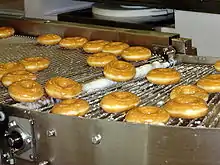Glaze (cooking technique)
A glaze in cooking is a coating of a glossy, often sweet, sometimes savoury, substance applied to food typically by dipping, dripping, or with a brush. Egg whites and basic icings are both used as glazes. They often incorporate butter, sugar, milk,[1] and certain oils.[2] For example, doughnut glaze is made from a simple mixture of powdered or confectioner's sugar and water that the doughnuts are dipped in, or some pastry doughs have a brushed on coating of egg whites. Glazes can also be made from fruit or fruit juice along with other ingredients and are often applied to pastries.[3] A type of glazed cake known as an entremet has gained worldwide popularity after a Russian confectioner's Instagram page became popular in 2016.[4] In contrast to frosted cakes, these pastries use "mirror glaze," which is glossier than normal glaze, so objects reflect on the surface.[5] A type of savory glaze can be made from reduced stock that is put on meat or vegetables. Some candies or confections may be coated in edible wax glazes. Glazed ham is a ham dish prepared using a glaze.[6]

History
A typical medieval English glaze was the 'Elizabethan' glaze made from lightly beaten egg white and sugar used predominantly on pastries of the time.
See also
References
- Rattray, Diana. "How To Make a Basic Cake Glaze". About.com. Retrieved 26 June 2013.
- "Super Easy Ways to Introduce Coconut Oil to Your Diet". Oily Oily. Retrieved 26 June 2013.
- "Fresh Fruit Glaze". Food.com. 14 June 2007. Retrieved 26 June 2013.
- Saelinger, Tracy. "These stunning, shiny cakes are making the internet drool". TODAY.com. Retrieved 2017-09-22.
- Iso, Justin. "White Chocolate Mirror Glaze Recipe (Video Technique)". www.chefiso.com. Retrieved 2017-09-22.
- Verberne, M.; Wahhab, I. (2016). Roast: a very British cookbook. Bloomsbury Publishing. p. 159. ISBN 978-1-4729-3549-6. Retrieved May 21, 2017.